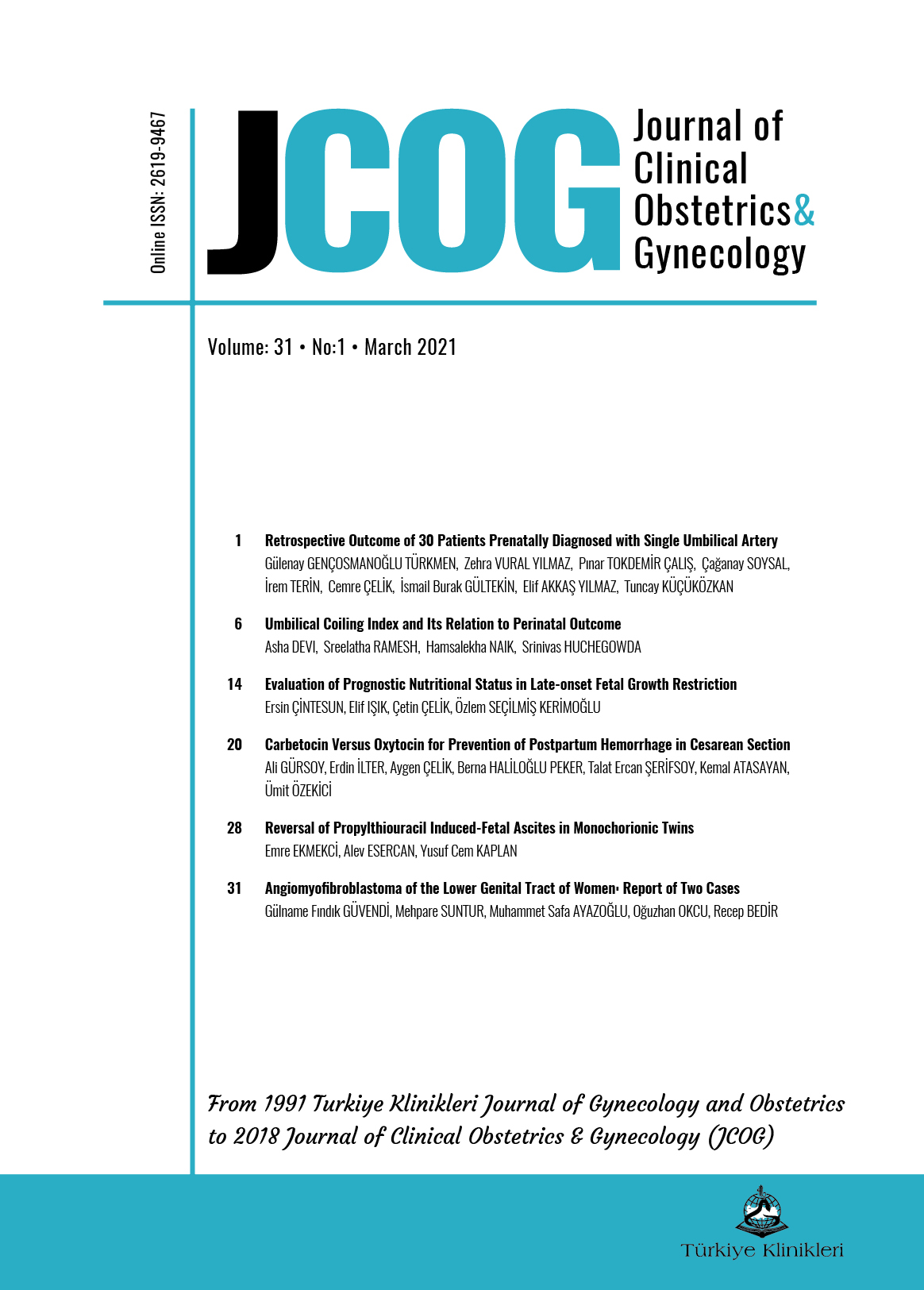Open Access
Peer Reviewed
CASE REPORTS
2549 Viewed871 Downloaded
Angiomyofibroblastoma of the Lower Genital Tract of Women: Report of Two Cases
Received: 11 Dec 2020 | Accepted: 04 Mar 2021 | Available online: 05 Mar 2021
J Clin Obstet Gynecol. 2021;31(1):31-4
DOI: 10.5336/jcog.2020-80547
Article Language: EN
Article Language: EN
Copyright Ⓒ 2025 by Türkiye Klinikleri. This is an open access article under the CC BY-NC-ND license (http://creativecommons.org/licenses/by-nc-nd/4.0/)
ABSTRACT
Superficial angiomyofibroblastoma of the lower genital tract of women is a very rare, benign neoplasm that most commonly arises in the vulvo-vaginal area. Our first case is a 45-year-old woman who presented with menometrorrhagia. On gynecological examination, a pedinculated polipoid mass 2.5 cm in size was found on the cervix. The second case is a 40-year-old woman presented with a nodular mass 5 cm in size on the vulva. She admitted to hospital with itching and cosmetic problems. Histologic examination revealed bland spindled and epithelioid cells arranged around blood vessels. Tumor cells have immunoreactivity for desmin, vimentin, estrogen and progesterone receptors but staining for cytokeratin was negative. In the lipomatous variant, the cells are dispersed into the adipose tissue. Differential diagnosis of lipomatous angiomyofibroblastoma includes; spindle cell lipoma, angiomyolipoma, and cellular angiofibroma. We will discuss the differential diagnosis of these cases with immunohistochemical and morphological findings.
Superficial angiomyofibroblastoma of the lower genital tract of women is a very rare, benign neoplasm that most commonly arises in the vulvo-vaginal area. Our first case is a 45-year-old woman who presented with menometrorrhagia. On gynecological examination, a pedinculated polipoid mass 2.5 cm in size was found on the cervix. The second case is a 40-year-old woman presented with a nodular mass 5 cm in size on the vulva. She admitted to hospital with itching and cosmetic problems. Histologic examination revealed bland spindled and epithelioid cells arranged around blood vessels. Tumor cells have immunoreactivity for desmin, vimentin, estrogen and progesterone receptors but staining for cytokeratin was negative. In the lipomatous variant, the cells are dispersed into the adipose tissue. Differential diagnosis of lipomatous angiomyofibroblastoma includes; spindle cell lipoma, angiomyolipoma, and cellular angiofibroma. We will discuss the differential diagnosis of these cases with immunohistochemical and morphological findings.
REFERENCES:
- Abdelaziz M, Eziba N, Sharma S, Kleven D, Al-Hendy A. Cervical superficial myofibroblastoma: case report and review of the literature. SAGE Open Med Case Rep. 2017;4;5:2050313X17726936. [Crossref] [PubMed] [PMC]
- Adams B, Fogarty P, McKenna M, McManus D. Superficial myofibroblastoma of the lower female genital tract: first case report of a pregnant patient. J Obstet Gynaecol. 2008;28(6):657-8. [Crossref] [PubMed]
- Seo JW, Lee KA, Yoon NR, Lee JW, Kim BG, Bae DS. Angiomyofibroblastoma of the vulva. Obstet Gynecol Sci. 2013;56(5):349-51. [Crossref] [PubMed] [PMC]
- Omori M, Toyoda H, Hirai T, Ogino T, Okada S. Angiomyofibroblastoma of the vulva: a large pedunculated mass formation. Acta Med Okayama. 2006;60(4):237-42. [PubMed]
- Giannella L, Costantini M, Mfuta K, Cavazza A, Cerami LB, Gardini G, et al. Pedunculated angiomyofibroblastoma of the vulva: case report and review of the literature. Case Rep Med. 2011;2011:893261. [Crossref] [PubMed] [PMC]
- Matsukuma S, Koga A, Suematsu R, Takeo H, Sato K. Lipomatous angiomyofibroblastoma of the vulva: a case report and review of the literature. Mol Clin Oncol. 2017;6(1):83-7. [Crossref] [PubMed] [PMC]
- Cinel L, Taner D, Nabaei SM, Dogan M. Aggressive angiomyxoma of the vagina. Report of a distinctive type gynecologic soft tissue neoplasm. Acta Obstet Gynecol Scand. 2000;79(3):232-3. [Crossref] [PubMed]
- Granter SR, Nucci MR, Fletcher CD. Aggressive angiomyxoma: reappraisal of its relationship to angiomyofibroblastoma in a series of 16 cases. Histopathology. 1997;30(1):3-10. [Crossref] [PubMed]
- Tochika N, Takeshita A, Sonobe H, Matsumoto M, Kobayashi M, Araki K. Angiomyofibroblastoma of the vulva: report of a case. Surg Today. 2001;31(6):557-9. [Crossref] [PubMed]
- Nielsen GP, Young RH. Mesenchymal tumors and tumor-like lesions of the female genital tract: a selective review with emphasis on recently described entities. Int J Gynecol Pathol. 2001;20(2):105-27. [Crossref] [PubMed]
MENU
POPULAR ARTICLES
MOST DOWNLOADED ARTICLES





This journal is licensed under a Creative Commons Attribution-NonCommercial-NoDerivatives 4.0 International License.










